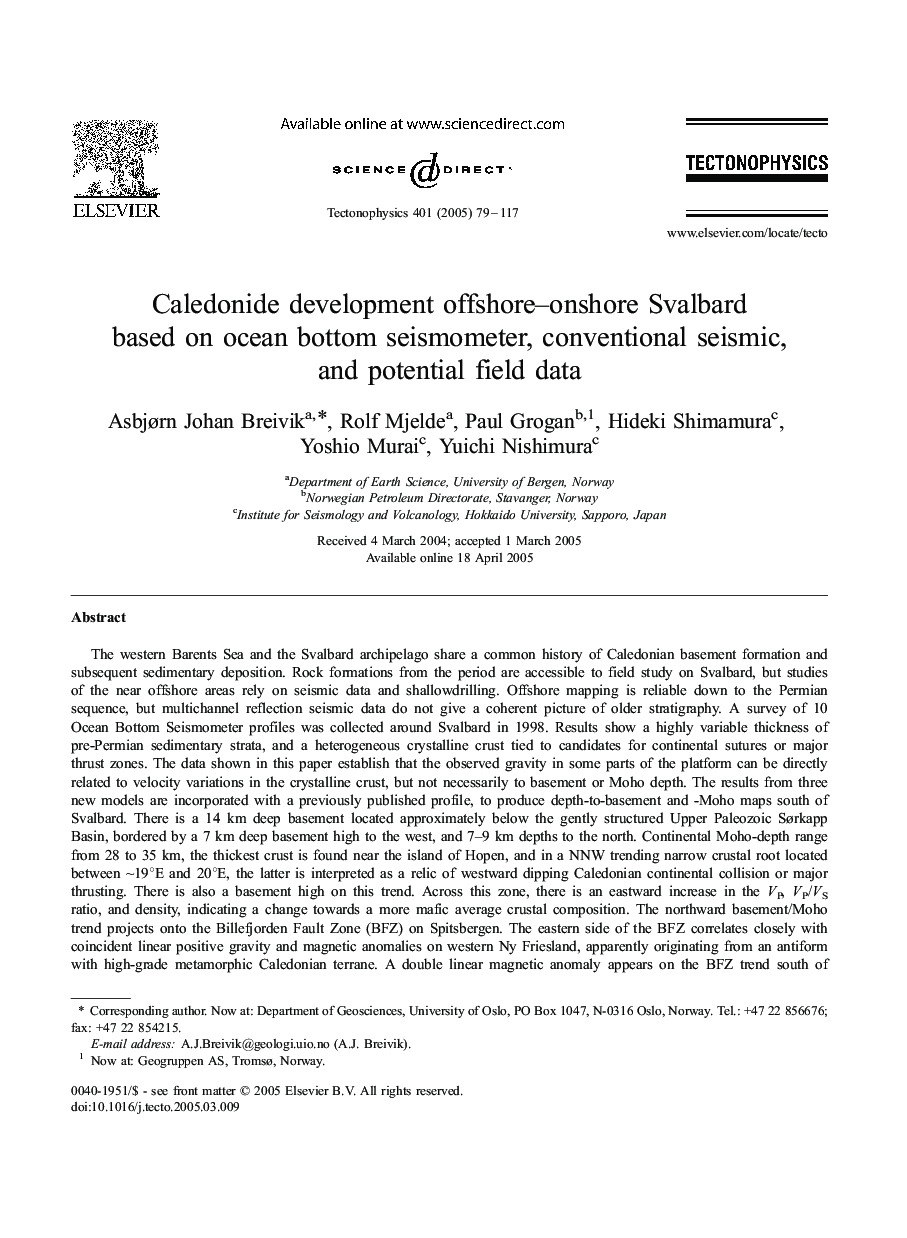| کد مقاله | کد نشریه | سال انتشار | مقاله انگلیسی | نسخه تمام متن |
|---|---|---|---|---|
| 9527185 | 1636981 | 2005 | 39 صفحه PDF | دانلود رایگان |
عنوان انگلیسی مقاله ISI
Caledonide development offshore-onshore Svalbard based on ocean bottom seismometer, conventional seismic, and potential field data
دانلود مقاله + سفارش ترجمه
دانلود مقاله ISI انگلیسی
رایگان برای ایرانیان
کلمات کلیدی
موضوعات مرتبط
مهندسی و علوم پایه
علوم زمین و سیارات
فرآیندهای سطح زمین
پیش نمایش صفحه اول مقاله

چکیده انگلیسی
The western Barents Sea and the Svalbard archipelago share a common history of Caledonian basement formation and subsequent sedimentary deposition. Rock formations from the period are accessible to field study on Svalbard, but studies of the near offshore areas rely on seismic data and shallowdrilling. Offshore mapping is reliable down to the Permian sequence, but multichannel reflection seismic data do not give a coherent picture of older stratigraphy. A survey of 10 Ocean Bottom Seismometer profiles was collected around Svalbard in 1998. Results show a highly variable thickness of pre-Permian sedimentary strata, and a heterogeneous crystalline crust tied to candidates for continental sutures or major thrust zones. The data shown in this paper establish that the observed gravity in some parts of the platform can be directly related to velocity variations in the crystalline crust, but not necessarily to basement or Moho depth. The results from three new models are incorporated with a previously published profile, to produce depth-to-basement and -Moho maps south of Svalbard. There is a 14 km deep basement located approximately below the gently structured Upper Paleozoic Sørkapp Basin, bordered by a 7 km deep basement high to the west, and 7-9 km depths to the north. Continental Moho-depth range from 28 to 35 km, the thickest crust is found near the island of Hopen, and in a NNW trending narrow crustal root located between â¼19°E and 20°E, the latter is interpreted as a relic of westward dipping Caledonian continental collision or major thrusting. There is also a basement high on this trend. Across this zone, there is an eastward increase in the VP, VP/VS ratio, and density, indicating a change towards a more mafic average crustal composition. The northward basement/Moho trend projects onto the Billefjorden Fault Zone (BFZ) on Spitsbergen. The eastern side of the BFZ correlates closely with coincident linear positive gravity and magnetic anomalies on western Ny Friesland, apparently originating from an antiform with high-grade metamorphic Caledonian terrane. A double linear magnetic anomaly appears on the BFZ trend south of Spitsbergen, sub-parallel to and located 10-50 km west of the crustal root. Based on this correlation, it is proposed that the suture or major thrust zone seen south of Svalbard correlates to the BFZ. The preservation of the relationship between the crustal suture, the crustal root, and upper mantle reflectivity, challenges the large-offset, post-collision sinistral transcurrent movement on the BFZ and other trends proposed in the literature. In particular, neither the wide-angle seismic data, nor conventional deep seismic reflection data south of Svalbard show clear signs of major lateral offsets, as seen in similar data around the British Isles.
ناشر
Database: Elsevier - ScienceDirect (ساینس دایرکت)
Journal: Tectonophysics - Volume 401, Issues 1â2, 25 May 2005, Pages 79-117
Journal: Tectonophysics - Volume 401, Issues 1â2, 25 May 2005, Pages 79-117
نویسندگان
Asbjørn Johan Breivik, Rolf Mjelde, Paul Grogan, Hideki Shimamura, Yoshio Murai, Yuichi Nishimura,